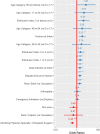Hospitalization for computer-assisted hexapod ring fixation application - analyses of patient variability, peri-operative complications, hospital costs, and discharge status
- PMID: 35248052
- PMCID: PMC8897910
- DOI: 10.1186/s12891-022-05171-6
Hospitalization for computer-assisted hexapod ring fixation application - analyses of patient variability, peri-operative complications, hospital costs, and discharge status
Abstract
Background: Computer-assisted hexapod ring fixation systems (HRF) are used for multiple conditions and in very diverse patient populations. This study analyzes perioperative outcomes following HRF application based on patient etiology and clinical presentation.
Methods: Data from patients in the Premier Hospital Billing Database between 2007-2019 undergoing HRF application were analyzed for the duration of patients' hospitalizations. Patients were grouped based on etiology: acquired deformity, arthrosis, congenital deformity, deep infection, infected nonunion, fracture, nonunion, and other post-operative complications. Demographics, comorbidities, operating room time (ORT), length of stay (LOS), peri-operative complications, and hospital costs were estimated using generalized linear models. Logistic regression evaluated factors associated with peri-operative complications.
Results: One thousand eight hundred eighteen patients (average age: 46.9, standard deviation (SD) (19.6) - 38.9% female) were included in the study, and included 72% fracture cases, 9.6% deep infection, 10.2% deformity (acquired: 5.9%, congenital: 4.3%), 4.2% nonunions, 2% arthrosis and 1.4% other sequelas from prior fractures. Comorbidities varied across diagnosis categories and age, 40% adults and 86% pediatric had no comorbidities. Pediatric cases mostly suffered from obesity (16.1%) and pulmonary disease (10.7%). Complicated diabetes was present in 45.9% of arthropathy and 34.3% of deep infection patients. ORT, LOS and inflation-adjusted hospital costs for all patients averaged 277.7 min (95% Confidence interval (CI): 265.1-290.3), 7.07 days (95% CI: 6.6-7.5) and $41,507 (95%CI: $39,728-$43,285), respectively, but were highest in patients with deep infection (ORT: 369 min (95%CI: $321.0-$433.8); LOS: 14.4 days (95%CI: $13.7-$15.1); Cost: $54,666 (95%CI: $47,960-$63,553)). The probability of having an intraoperative complication averaged 35% (95%CI: 28%-43%) in adult patients with deep infection vs 7% (95%CI: 2%-20%) in pediatric cases treated for congenital deformity. The risk for intraoperative complications was mostly associated with preexisting comorbidities, an Elixhauser > 5 was the most predictive risk factor for complications (odds ratios: 4.53 (95%CI: 1.71-12.00, p = 0.002).
Conclusions: There is important heterogeneity among HRF patients. Adults with HRF for fracture, deep infection and arthrosis are at far greater risk for peri-operative complications vs. patients with deformity, especially pediatric deformity cases, mostly due to existing comorbidities and age. Device-specific HRF clinical studies cannot be generalized beyond their exact patient population.
Keywords: Complications; Costs; Hexapod ring fixation; Hospital; Long bone deformities; Resource utilization.
© 2022. The Author(s).
Conflict of interest statement
MV, AC, CEH, and CS are employees of Johnson & Johnson (JnJ) and own stock in the company. BR was a contractor with JnJ at the time of the study. JSR is a consultant for JnJ but holds no stock nor receives royalty payments.
Figures



References
-
- Tsibidakis H, Kanellopoulos AD, Sakellariou VI, Soultanis K, Zoubos AB, Soucacos PN. The role of Taylor Spatial Frame for the treatment of acquired and congenital tibial deformities in children. Acta Orthop Belg. 2014;80(3):419–425. - PubMed
MeSH terms
LinkOut - more resources
Full Text Sources

